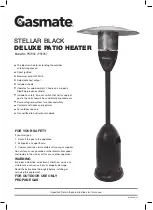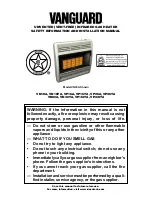
40
SECTION VII: GAS CONNECTIONS
WARNING
Connect this water heater only to the type of gas as shown on the rating plate. Use clean black iron pipe
or equivalent material approved by local codes and ordinances. (Dirt and scale from the pipe can enter
the gas valve and cause it to malfunction). The inlet gas line must have at least a 3 inch (7.62 cm) drip
leg (sediment trap) installed as close to the water heater’s gas valve as possible. A ground joint union
must be installed in the gas supply line, as close to the water heater as possible, to permit servicing of the
water heater. Compounds used on the threaded joints of the gas piping must be resistant to the action of
liquefied petroleum gases/propane gas. DO NOT apply pipe dope to the gas valve inlet and make certain
that no pipe dope has become lodged in the inlet screen of the gas valve. Extreme care must be taken to
ensure no pipe dope enters the gas valve and to avoid excessive torque when tightening the gas supply
line to the gas valve. Excessive torque may result in cracking of the gas valve housing. The suggested
maximum torque is 31.5 foot lbs. (4.4 kg-m). The manufacturer of this water heater will not be liable for
any damage or injury caused as a result of a cracked gas inlet as a result of excessive torque.
This water heater and its gas connection must be leak tested before placing the water heater in operation.
Check for gas leaks with a soap and water solution and a brush or a commercial leak detector fluid.
NEVER USE A MATCH OR OPEN FLAME FOR TESTING!
The water heater is not intended for operation at higher than 10.5 inches water column, for natural gas,
13.5 inches water column for L.P. supply gas pressure. Higher gas supply pressures require
supplemental reducing service regulation. Exposure to higher gas supply pressure may cause damage to
the gas controls, which could result in fire or explosion. If overpressure has occurred such as through
improper testing of gas lines or emergency malfunction of the supply system, the gas valve must be
checked for safe operation. Make sure that the outside vents on the supply regulators and the safety vent
valves are protected against blockage. These are parts of the gas supply system, not the water heater.
WARNING
Conversion of this unit from natural gas to L.P. or L.P. to natural gas CANNOT be done in the field. If the
gas supply does not match the type shown on the water heater rating plate, then contact your supplier for
the proper water heater for the building gas supply.
CAUTION
The water heater and individual shutoff valve must be disconnected from the gas supply piping system
during any pressure testing of the system at test pressures in excess of ½ psi (3.5 kPa). The water
heater must be isolated from the gas supply piping system by closing its manual shutoff valve during any
pressure testing of the gas supply system at test pressures equal to or less than ½ psi (3.5 kPa). The
supply line must be capped when not connected to the water heater.
If copper supply lines are used, they must be internally tinned and certified for gas service.
The gas supply lines must meet all requirements of the National Fuel Gas Code ANSI Z223.1 (Latest
Edition), or in Canada CAN/CGA B149.1 Natural Gas Installation Code (Latest Edition) or CAN/CGA
B149.2 Propane Installation Code (Latest Edition). The gas supply line may need to be larger for the
EVERHOT
®
water heaters than a storage water heater in the case of a replacement installation. Refer to
the piping capacity tables at the end of Section VII, “Gas Connections” and in the codes referenced
above.
WARNING
A 3” (7.6 cm) drip leg (sediment trap) is required ahead of the gas inlet connection to the water heater.
See water heater installation illustration. Install a manual gas shutoff valve before the gas inlet
connection to the water heater before connecting to the gas line. A union should be installed before the
water heater gas connection for disconnection for servicing. Refer to the piping diagrams (Fig. 2-5) in
Section V, “Water Connections”.
Check the type of gas and the gas inlet pressure before connecting the EVERHOT water heater to the
gas supply. If the gas supply type does not match the type shown on the water heater rating plate, then
DO NOT connect the water heater. Contact your supplier for the correct water heater.
Summary of Contents for IGI-180C-5N
Page 7: ...7 EVERHOT IGI Model Series Dimensions Figure 1...
Page 14: ...14 Recommended Piping for a Basic Installation Figure 2...
Page 15: ...15 Recommended Piping for a Circulation System Figure 3...
Page 35: ...35 Horizontal Vent System Installation examples Figure 36...
Page 38: ...38 Vertical Vent System Installation examples Figure 40...
Page 39: ...39 Cut Line Template Figure 41...
Page 44: ...44 Wiring Diagram Schematic Figure 43...
Page 59: ...59 Schematic Diagram of Internal Parts Figure 53...
Page 61: ...61 Internal Components...
Page 62: ...62 Internal Components...
Page 63: ...63 Electrical Components...
Page 67: ...67 NOTES...
















































